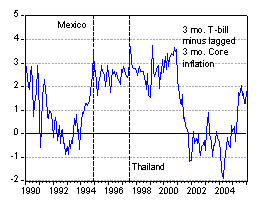Some other possible consequences of monetary tightening.
I’ve been reading several books on the financial crisis literature, among them Nouriel Roubini and Brad Setser’s Bailouts or Bail-ins? (IIE, 2004) and Peter Isard’s Globalization and the International Financial System (Cambridge, 2005). Upon first reflection, it struck me that the books didn’t appear particularly timely, given our current concerns with global rebalancing, and the role of China. But then, I recalled this picture relating capital flows to emerging markets and US real interest rates.

Capital flows to emerging markets and real US interest rates. Source: Chinn (2005), based on WEO 2003 data.
A one percentage point increase in the US real rate decreases capital flows in the subsequent year by about 20 billion 1995 constant dollars, 26 billion current dollars. This correlation is consistent with Frankel and Roubini’s (2003) finding that the IFC Global index of equities declines by 17 ppts for each one ppt increase in the real G-7 interest rate, while the Emerging Markets Bond Index (EMBI) declines by 34 percent (similar magnitudes are obtained if one uses the real Fed Funds rate instead of the G-7 real rate).
Now the recent moves in the US short term rate can be viewed along a new dimension. In the figure below, the US three month T-bill rate (secondary market) adjusted by the lagged annualized 3 month core CPI inflation rate, is plotted.

US real 3 month T-bill rate. Source: St. Louis Fed.
Recent crisis coincide with upward movements in the real rate. While the current rate is fairly low, the swing of 4 percentage points is comparable to the one preceding the 1994 Mexican peso crisis.
So, expect some surprises in places expected and unexpected.
Technorati Tags: financial crises,
real interest rates,
emerging markets,
Woah. If that relationship between capital flows and real rates holds true, the implication is for some serious, negative feed through to emerging markets in the months ahead. That said, I wonder if real-rate differentials may be more appropriate to use, and whether this would give us a different picture?
Also, emerging markets and other risky assets continue to perform very strongly, despite an expected reduction in global liquidity as rates rise in the US and elsewhere. What to make of this?
My intuition is that the level is important too. People have been buying risky assets such as EMs because they need a decent yield. I am not sure that 5% bills will be enough to lure them back to the US. (See yesterdays TIC data for example).
That graph would tend to suggest impressively high returns in emerging markets, no?
shothotbot, I initially thought the starting level was very important as well. I agree that even 5% isn’t very much reward in real terms.
But now I think there is a big offsetting factor: if investors who have bought risky assets have funded their here trades using the front-end of the curve for borrowing, where the cost of borrwing would have been lowest, then the increase in the financing cost for these investors is pretty severe. For example, if funds could get money at close to the Fed funds rates, then the increase from 1% to 4.5% is a theoretical increase of 3.5x. Pretty painful, but is it enough to produce an unwinding of the carry trade and accelerate a flight away from risky assets?
Maybe Mish is pointing out some surprises:
http://globaleconomicanalysis.blogspot.com/2006/03/mideast-contagion.html
http://biz.yahoo.com/ap/060317/gm_accounting.html?.v=7
I trade emerging market debt and foreign exchange professionally, and if anything capital flows into these markets have accelerated over the past 6 months. My sense of these markets is a euphoria similiar to the nasdaq in early 2000 or Asia in 1997. If the interest rate / capital flow relationships outlined in this article revert to the mean, as I expect they will, this will be extremely painful for emerging markets and risky assets in general.
Where’s the tight moey policy? M2 has been growing at a very nice rate,although a bit slower in recent weeks. Nothing to worry about now.
http://www.telegraph.co.uk/money/main.jhtml?xml=/money/2006/03/14/cnice14.xml&menuId=242&sSheet=/money/2006/03/14/ixcity.html
Says:
“Iceland’s banks were pummelled yesterday as the Nordic economy lurched into its third week of crisis, flashing an ominous early-warning signal for markets worldwide.
The krona tumbled another 3pc against the US dollar and is now down almost 18pc this year, a victim of “hot money” flight by investors scrambling for the exit doors at the same time. Reykjavik’s blue-chip stock index was down 3.3pc.
The cost of insuring against a bond default by Iceland’s three big banks – Kaupthing, Landesbanki, and Islandibanki – shot up another 20 basis points yesterday as investors became increasingly alarmed over their use of foreign debt to fund an equity spree. “This is a warning sign the euphoria we’ve se en in global markets is dissipating rapidly,” said Julian Callow, an economist at Barclays Capital.
Funds had piled into Iceland to milk 10.75pc rates but panicked after warnings of a “hard landing” by the credit agency Fitch. The krona’s crash set off global dominos, hitting New Zealand, South Africa, Hungary, Poland and Turkey. The rumbling thunder of monetary tightening by all the world’s big central banks provided the background music.”
Excerpts from the China Daily 12/05/2005: Red Alert
“As the Chinese economy expanded, the nation’s short-term foreign debt rose to US$141.3 billion at the end of June this year, a situation that accounted for an alarming 53.1 per cent of total foreign liabilities, compared to 9 per cent at the end of 2000, the State Administration of Foreign Exchange (SAFE) said late last month.
Should any major problem occur in the domestic economy, says Tan Yaling, a senior researcher with the Bank of China, a premature withdrawal of short-term funds would deal a blow to the economy.
“That’s what happened in Thailand and Mexico as well as Argentina,” she says, citing the major financial crises in emerging markets in the late 1990s.
Given the continued expectations for a stronger renminbi and still strong momentum in foreign trade growth, trade credits, which accounted for 53 per cent of all China’s short-term debt at the end of June, are not seen heading in the opposite direction.
China’s hefty forex reserves, which stood at the equivalent of 503.2 per cent of outstanding short-term liabilities at the end of June, provide ample resources to pay off debts, the report notes. The internationally accepted safe level is 100 per cent.
Tightened supervision, coupled with higher borrowing costs as interest rates climbed in the United States, brought the growth of total foreign debt down by 9.8 percentage points to 7.5 per cent at the end of June.”
An interesting article from China. The two basic assumptions are the continued expectation of a stronger renmimbi and momentum in the export market. If the momentum in exports falls, say through a US consumer pullback, the US interest rates continue upwards which would, presumably, accelerate the withdrawl of “hot” money, and China has to pay off debts with reserve dollars, will the stable disequilibria of the forex market come undone?
Tijuana tech firms hire scientific talent at half the salaryIn Baja California, firms benefit from low costs
U.S. medical-device companies such as Medtronic Inc. and DJ Orthopedics Inc. employ 23,700 people in Baja California, compared with 6,000 working in the industry in San Diego. Last year, Wilson Greatbatch Technologies Inc., a producer of components for implantable medical devices, closed its facility in Carson City, Nev., and opened a plant here.
Of the more than 60 medical-device companies operating in Baja, at least 40 have U.S. parent companies and 13 of those have a significant San Diego presence, according to the report by San Diego Dialogue, which is affiliated with the University of California, San Diego.
http://www.miami.com/mld/miamiherald/business/14126790.htm
A bit off topic. But thought I would start to keep people up-to-date on mythical offshoring.
First in a series.
By the way, for a year now, I have had a Google automatic search for “Foreign Companies China.” I usually get about about ten finds a day.
The article just cited concerned Baja’s hope it had stemmed the competition with China: Many of the American firms there (NAFTA) had been moving to China. Mexico is having a hard time competing with China’s cheap labor (loss of 57,000 workers 2001-2002.
Such is the domino effect of labor arbitrage.
Carnival of the Capitalists – March 20 2006
It’s great to welcome back the Carnival. Don’t forget to check out next week’s host: Decker Marketing.
Before we get into the Carnival, Robert and Jay asked me to annouce Jotzel. If you need a daily fix of the Carnival, check it out and get your steady
If you see this artcle
American presntly leaderless and clueless:
http://www.economyincrisis.org/
We are producing less as we now outsource much of our manufacturing. We are borrowing more (from any country that is willing to lend us money) and are selling thousands of our best wealth producing companies even whole industries including 75% of the movie industry, 81% of the cement industry, 63% of the book publishing industry, 100% of the TV manufacturing industry and many others.
Our economic profile will soon approach that of a third world country or a colony and our standard of living may recede to conditions of the early 30?s attendant with massive unemployment and severe social problems.
And in the same page see:
Foreigners Are Losing Respect For The Value Of The Dollar
What happens if we stop supporting our dollar through higher rates? The past two and a half years show that it will probably drop dramatically
AAmerica is no longer an eempire,yes we could say and attach the name name of Empire as Debt Empire,
“Instead of trade and work, imperialism breeds militarism, inflation, and debt, as Bonner and Wiggin show. Yet there is a golden hope in freedom and honest money.”
(As the Anglo-Saxon economies lost their competitive edge in manufacturing, they tried to make up for it by encouraging consumption. This is the biggest fraud of all. At first, higher consumption feels good. It is like burning the furniture to keep warm; it feels good for a moment. But the sense of well-being is extremely short-lived. When people borrow and spend, they feel as though they are getting richer — especially when their houses are rising in price. The increased consumption even shows up, indirectly, in the GDP figures as growth. But you don’t really become wealthier by making things you can sell to others — at a profit. The point is obvious but, at this stage of imperial finance, it was inconvenient.)
please see EMPIRE OF DEBT:
http://www.authorviews.com/authors/bonner/bonner-obd.htm
by Bill Bonner and Addison Wiggin
This will give u an idea to see for yr self why yr main stream media committing crime on you, and u will be a different person for sure if u were dependant only on the main stream who in fact the real ruler of the America. God bless America and bless u to keep its constitution as the founding father wanted it.